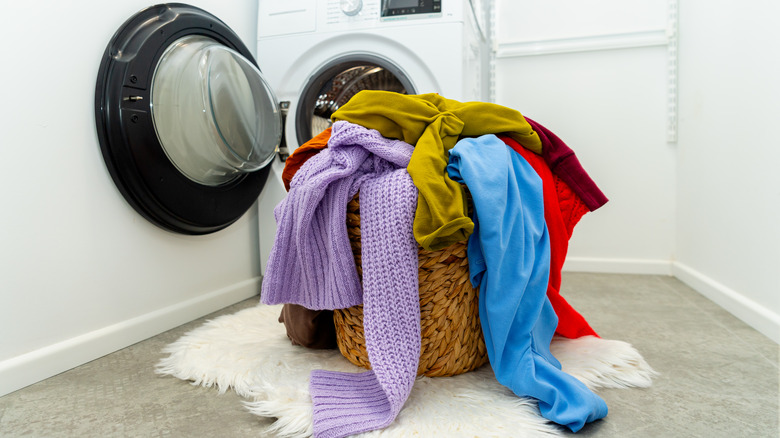Our Appliance Expert Tells Us If There Are Benefits To Letting Your Dryer Rest Between Loads
Ah, the sounds of the typical American household. Oh, sure, the pitter-patter of little feet ... or maybe paws. But mostly, it's the sound of cleaning machines: a robot vacuum whirs against its invisible walls, the dishwasher's occasional muffled woosh or thunk, and mostly the sound of a washer and dryer going nonstop in the laundry room. Shouldn't they get a break? If we know anything about machines, it's that they're not usually engineered to run ceaselessly, right? Especially a clothes dryer, with all that heat. House Digest interviewed Frontdoor virtual appliance expert Garret Bergstrom about it, and he gave us his exclusive take: modern dryers are built for steady use, but operating them uninterrupted can worsen existing problems under the right circumstances.
"In a single-family home, dryers are designed to run multiple cycles a day. Doing back-to-back drying loads should not cause problems to the dryer unless there is something wrong with the dryer prior to running back-to-back cycles," Bergstrom told us. "Once issues arise on a dryer, they worsen with use, and a minor squeak turns into a mind-bending scream." And it turns out that overusing a dryer isn't just about back-to-back cycles, but also about drying times.
The effects of load size and drying cycle length
It seems reasonable to expect that heavier loads would strain a dryer worse than light ones, but in the exclusive interview with House Digest, Bergstrom told us that small loads could create more wear and tear for your dryer. "Auto Dry cycles allow dryers to sense the moisture content of the clothing in the dryer and should adjust the time accordingly," he said. "Small loads can actually make dry times longer on auto cycles. The clothes will tumble to the back of the drum and not hit the moisture sensors towards the front, causing the unit to think the clothes are dry and end the cycle prematurely. Good full loads are the best bet all around." So, think twice before drying a smaller load to save time on laundry day.
On the other hand, constant use can allow heat to build up in a dryer, which can somewhat speed up drying cycles. "If running multiple loads one after another, there will be more heat retention throughout the dryer, which might speed up drying cycles," Bergstrom said. However, he also pointed out that the effect on drying cycle length might not be as large as you might expect because the cool-down period that happens automatically at the end of most drying cycles can erase the heat retention advantage.
Improving your odds of a long-lasting dryer
To some extent, this aspect of dryer care is a matter of probability. Overusing a dryer might not doom it to an imminent demise, but it can increase the odds that moving parts and other components that are sensitive to length of use will have problems. "There are some dryer parts that will wear out with usage; this is normal," Bergstrom told House Digest in an exclusive interview. "The more you use any appliance, the faster they will wear down. However, dryer parts (which include glides, rollers, belts, bearings, etc.) are generally stout and long-lasting."
Improving your odds of getting through a day of laundry is, to some extent, about making that day less strenuous for your dryer. "Luckily, most dryers and major appliances are built for everyday, multiple use. However, the more you use your dryer, something could go wrong," Bergstrom said. "Better for the appliance is preventing laundry from building up for an entire day of dryer usage and staggering use." How you prevent laundry from building up is itself not a problem with a simple solution. You can make inroads by learning how to create a truly functional laundry room and getting a handle on all your laundry machine settings and, perhaps especially, on all your dryer settings.


